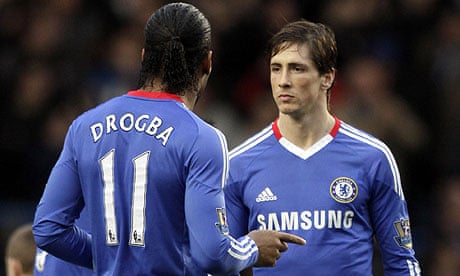Carlo Ancelotti would appear to have an embarrassment of riches up front but with his team's season hinging upon the next few weeks, he may now have to be ruthless when it comes to selection and brave when it comes to tactics. In my opinion he has to switch the shape of his line-up and pick his best twosome up top.
Forwards depend on service from midfield team-mates and defenders breaking in support. But, as individuals, strikers have to possess certain qualities – pace, strength, skill, awareness – if they are to flourish. An ideal frontline has a combination of those assets, yet there is always a danger of falling into the trap of trying to accommodate players of similar styles. You must always have a balance. It is that which Chelsea lack.
In Fernando Torres, Nicolas Anelka, Didier Drogba and Salomon Kalou, not forgetting Daniel Sturridge and Gaël Kakuta, who are out on loan, Ancelotti boasts a wealth of attacking talents happiest in central roles. The temptation must be to pick his best three – presumably Drogba, Torres and Anelka – in his favoured 4‑3‑3 and trust them to strike up an understanding, but I know from my own experience that, as a tactic, that does not always succeed. I wrestled unsuccessfully to accommodate David Hirst, Andy Booth, Benito Carbone and Paolo di Canio at Sheffield Wednesday, and Jermain Defoe, Frédéric Kanouté and Robbie Keane at Spurs.
Ancelotti likes to play narrow with a holder at the base of a midfield diamond or threesome. But his diamond has rarely sparkled and, in recent months, his 4‑3‑3 has not been generating enough goals. Perhaps the time has come to switch system and philosophy as the forwards themselves might enjoy the benefits of 4‑4‑2. Strikers have traditionally hunted in pairs and while tactics do evolve, Chelsea's immediate priority is to maximise Torres. In him they have a £50m forward who is a good shooter, strong in the air and who runs down the channels with ease. He needs to play, but he can combine with a partner just as well as he can conjure brilliant individual actions. Ancelotti must give him that partner.
Anelka may be too similar to the Spaniard in terms of style, and the new arrival will score more goals over a length of time than the Frenchman. Drogba, with his strength, would appear to be Torres's natural foil – a battering ram who can hold players off – and he, too, may benefit from the switch.
Splitting the front players in a 4-3-3, 4-1-2-3 or 4-2-1-3 has become the modern mode since our coaches looked at youth international tournaments and became obsessed with the possibilities. But every system has a flipside. Against Everton, Drogba played through the middle, with Florent Malouda and Kalou in slightly wider roles. Yet Phil Jagielka marked the lone forward and enjoyed the knowledge that Sylvain Distin was parading alongside ready to pounce if required. Having that cover gave Jagielka the opportunity to get skin tight. Surely Everton's centre-backs would have been less comfortable confronting a front pairing, denying them the chance to cover each other's potential errors?
Drogba needs a colleague close by with whom he can combine. Here the nearest was Frank Lampard, a player who revels when breaking with or without the ball from the middle. The England midfielder is probably the principal beneficiary of the 4-3-3, forever sniffing out the space between the three ahead. But surely Lampard could flourish behind a two-man strike-force just as efficiently? After all, he could support from just off the strikers and drag opposing defenders into uncomfortable areas. The time may have come for a change.

Comments (…)
Sign in or create your Guardian account to join the discussion